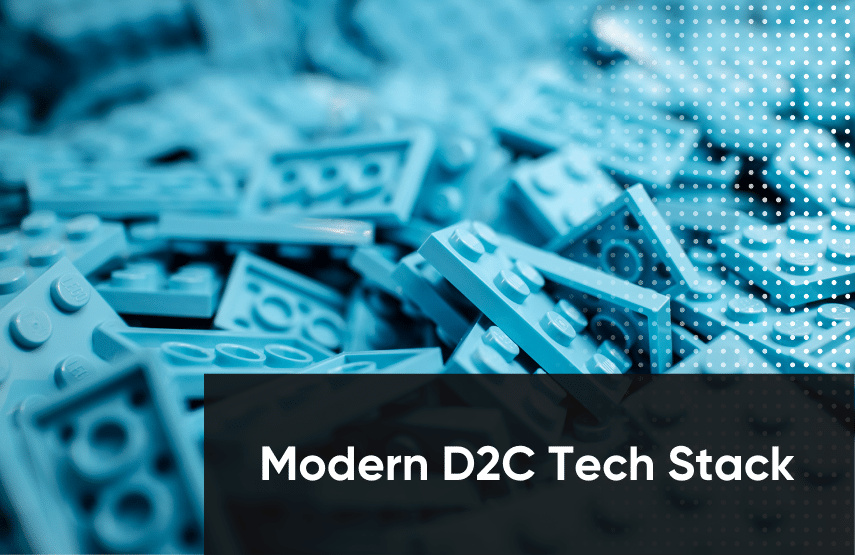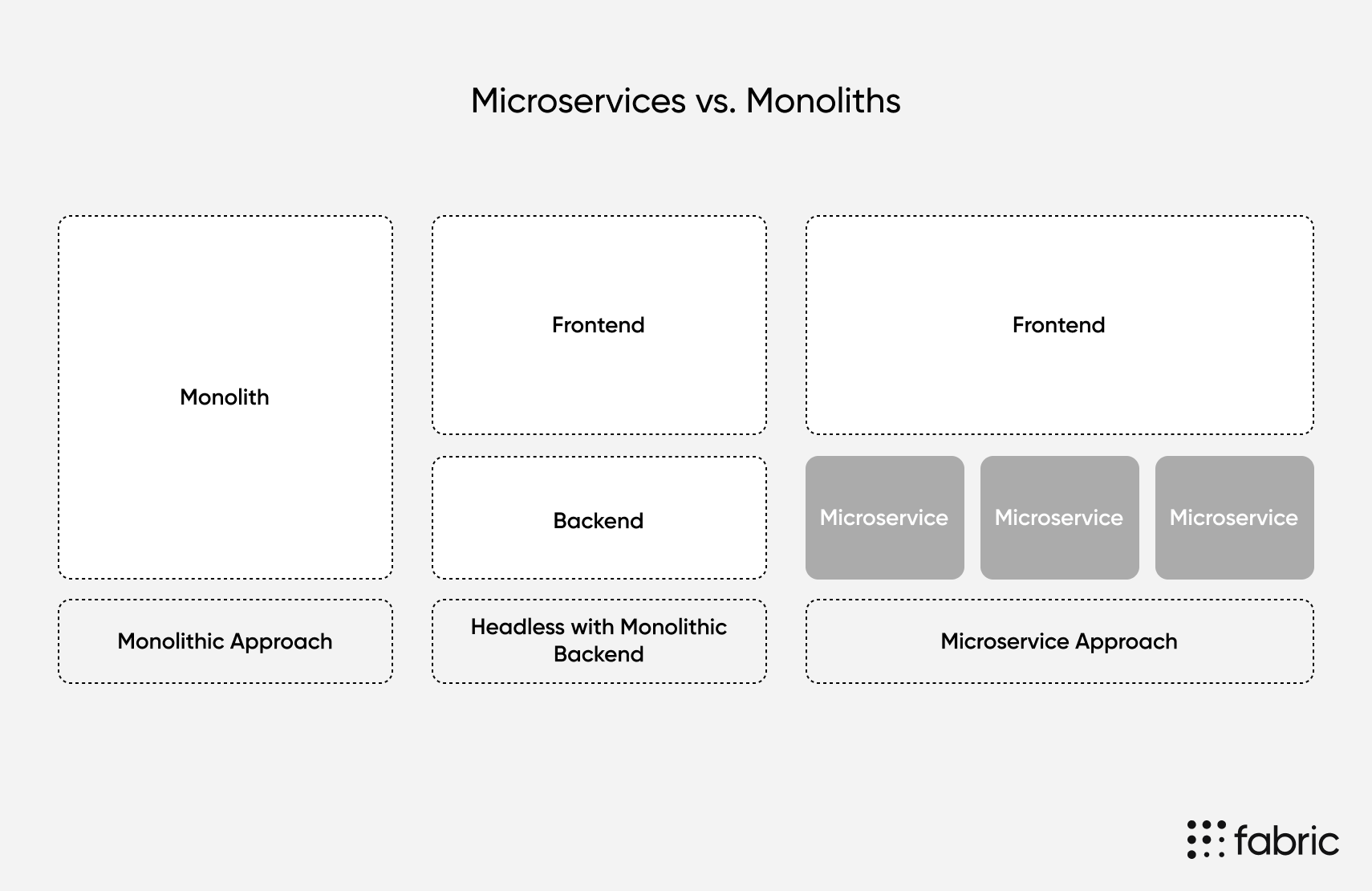Building a Modern D2C E-Commerce Tech Stack

D2C (direct-to-consumer) e-commerce simply means that a business sells its products directly to end consumers via a dedicated e-commerce site. It’s a strategy that arguably offers the most opportunities to facilitate direct connections with consumers and turn them into brand advocates.
D2C e-commerce differs from other strategies like B2C or B2B in that no other retailer is involved in the buying process and the end buyer is an individual rather than a business. Instead, they tend to build an end-to-end suite of services that handles their own inventory management, order management, logistics, supply chain, discounts, and returns. Warby Parker, IQBAR, ButcherBox, and BarkBox are all examples of D2C businesses.
Managing all the moving parts of a D2C business means complexity builds up over time, requiring a strong tech infrastructure. So let’s talk about how to build a modern, scalable, robust D2C e-commerce platform, and all the technical considerations, architectural decisions, and tools that go with it.
[toc-embed headline=”Developer Considerations for D2C E-Commerce”]
Developer Considerations for D2C E-Commerce
Since the software behind a D2C business is handling complex logic to process and fulfill orders, it’s important to keep a few specific factors in mind.
Speed
Slow websites lose customers to better-performing websites, and poor website performance reflects badly on brand image. Google confirms that site speed is one of the most important factors in its ranking. A slow website that’s dragged your search ranking down can impact sales.
Clearly it’s important to build a fast-running application. How fast your website loads depends on a variety of factors: your web host, the static files served, and the size of the code and operations performed by the code on your site. File types and code are the only things that you can optimize. For hosting, regular due diligence is required.
Reliability
Any downtime has a detrimental effect on e-commerce revenue, especially during peak traffic times. Customers are unable to view products or complete orders, among a host of other problems. Even one poor customer experience can make a dent in a business’s reputation, and then you’re dealing with much more than lost revenue. So your application’s reliability has to be high.
Product Customization
E-commerce is going through a change where business interfaces look more like a customized, welcoming online store for visitors rather than just a list of products. Businesses have started to personalize website content such as products, images, and offers according to visitor demographics, interests, and order history, leading to better user engagement and increased orders. So you’ll need to build an application that extensively supports customization.
Security
E-commerce application security is crucial for many reasons, especially to protect customer data and guard against fraud. When security is not implemented properly, both merchants and customers are at serious risk.
By providing a safe place to perform online transactions, you will in turn create trust with your end customers and improve your application’s reputation.
[toc-embed headline=”Architectural Considerations for D2C E-Commerce”]
Architectural Considerations for D2C E-Commerce
Several potential solutions exist for a concrete, well-designed architecture for a D2C e-commerce system. Your choice should be the result of a conscious, collaborative selection process, with an understanding of how the various architectural tactics and patterns, integration technologies, middleware, and related implementation strategies all work together. Your goal is a robust system that fits the needs of both your brand and your customer.
Microservices vs. Monoliths
Microservices is an architectural style that structures an application as a collection of services that are:
- Highly maintainable and testable
- Loosely coupled
- Independently deployable
- Organized around business capabilities
A monolithic architecture, on the other hand, is a single application consisting of multiple services, deployed as a whole and not easy to test and maintain. Most large-scale websites, including Netflix, Amazon, and eBay, have evolved from a monolithic architecture to a microservice architecture.
Amazon originally had a two-tier architecture. In order to scale, they migrated to a service-oriented architecture consisting of hundreds of backend services. Several applications call these services, including the applications that implement the Amazon.com website and the web service API. The Amazon.com application calls 100-150 services to get the data that’s used to build a web page.
Clearly, microservices architecture doesn’t necessarily mean simplicity. It can add up a lot of complexity at the same time it helps you iterate faster. Integration with other services, data transaction management, and log monitoring become complex over time. A service mesh can help, but even that means more code to run and maintain. A lot of development hours are required to build your own microservices.
To get the scalability benefits without the time investment, you can look into a third-party microservice provider like Fabric. You can use some or all of their e-commerce services to bridge the gap between building microservices from scratch and ensuring that your backend is reliable and scalable.
Headless Commerce vs. Full Stack
Headless commerce is an e-commerce solution that stores, manages, and delivers content without a frontend delivery layer. With a headless commerce platform, the frontend (or the “head”) has been decoupled and removed, leaving only the backend. In contrast, traditional commerce platforms have a predefined frontend and are tightly coupled with the backend.
In the past few years, preferences have changed dramatically in favor of separated front and backends, often using a headless CMS or RESTful API. However, keep in mind that just because the big corporations are doing something, it doesn’t mean it’s the best fit for everyone:
“As you expand beyond finding product-market fit into a mid-market company, you must begin to do things like uniquely express your brand experience, add customer segments beyond your early adopters, add product selection, and start to add channels including retail, wholesale, third-party marketplaces, and more. Growing up is awesome, but you need to be thoughtful to make sure your starter tech stack doesn’t limit your growth.” –Faisal Masud, CEO at Fabric
So if your development team is small and your e-commerce experience is simple, you can probably skip the headless approach. On the other hand, if you’re scaling up your distribution channels, you want more control over the customer experience, or you want to improve performance dramatically, a headless e-commerce platform might be the way to go.
Integrating with Third Parties vs. Building It All Yourself
Having a dedicated software development team is blissful, but building a robust, secure, reliable D2C e-commerce system requires a lot of effort, and it may take a lot of time to deliver. But the availability of specialized APIs as a service could mean that building a customer-centric D2C e-commerce platform takes less time than it used to.
A better approach involves building core features in-house and using third-party vendors for specific functionalities that they’re best known for. For example, you could use Fabric OMS and PIM but handle the frontend development in-house. This lets you control the user interface while leveraging the power of a microservice-based headless platform that’s ready to use.
Relational vs. NoSQL Databases
A database is an important part of D2C e-commerce because it gives the possibility to store, organize, and manage each kind of data. And it eventually dictates your application performance, stability, reliability, speed, and security.
Typically, relational databases like SQL, MySQL, and Postgres have been the most common. They’re mature, proven, and widely implemented. Relational databases provide a store of related data tables that have a fixed schema and use SQL to manage data and support ACID guarantees.
If you need non-relational data stores, then you might use NoSQL databases like MongoDB, Cassandra, and Redis. Instead of joining tables of normalized data, NoSQL stores unstructured or semi-structured data, often in key-value pairs or JSON documents. ACID is not guaranteed here beyond the scope of a single database partition.
In general, a hybrid approach where you have a mix of relational and NoSQL database design in your system is an interesting and much better option.
| Consider a relational database when… | Consider a NoSQL datastore when… |
|---|---|
| You work with complex queries and reports. | Data retrieval is simple and tends to be flat. |
| Your users are more centralized. | Your data requires a wide geographic distribution. |
| ACID guarantees are required. | Your workloads don’t require ACID guarantees. |
| Your workload volume is consistent and requires medium to large scale. | You have high volume workloads that require large scale. |
[toc-embed headline=” “]
[toc-embed headline=”Programming Languages, Frameworks, and Libraries”]
Programming Languages, Frameworks, and Libraries
The right programming language can speed up development time. Given the availability of popular open source frameworks and libraries, many known issues are solved quickly by the community. You can also customize per your D2C e-commerce requirements and cut down on development time when you need to integrate with third-party services or build common functionality.
As per the Stack Overflow 2020 survey:
- Rust, TypeScript, Python, Kotlin, Go, JavaScript are the programming languages that developers are using and have expressed interest in continuing to use. You can use this insight to select a programming language for your application.
- ASP.NET Core, React, Vue.js, Express, Gatsby, Spring, and Django are the most popular web frameworks.
- Redis, PostgreSQL, MongoDB, MySQL, and Cassandra are the most popular databases.
For the eighth survey year in a row, JavaScript has maintained its stronghold as the most commonly used programming language. TypeScript, Go, and Kotlin are newer, trendier technologies. By paying attention to such patterns and data, you can start building your core tech components with popular technologies, which will in turn help you find developers so you can get up to speed more quickly.
[toc-embed headline=”Conclusion”]
Conclusion
Building customer-centric D2C e-commerce applications comes with challenges that you’ll need to solve as your system progresses: speed, performance, reliability, security, payments, order management, promotions, inventory management, shipment, logistics, and warehousing, just to name a few. Fortunately, most of these have proven solutions that have been put to the test by established e-commerce companies.
You can either try to build a platform that can solve all these challenges yourself or consider a hybrid approach with a platform like Fabric. A headless backend can give you access to flexible, scalable microservices that you can easily integrate with your existing ERP, frontend, and office systems.

Tech advocate and writer @ fabric.
